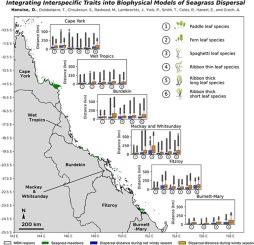将种间特征整合到海草扩散的生物物理模型中
IF 3.2
3区 环境科学与生态学
Q2 ECOLOGY
引用次数: 0
摘要
海草草甸的恢复力在很大程度上取决于其繁殖体的扩散,繁殖体的扩散促进了扰动后的恢复和补充。然而,由于缺乏经验观测,预测动态沿海环境和大时空尺度的扩散模式仍然具有挑战性。生物物理模型将海洋和大气驱动因素与物种特有的特征(如浮力和寿命)结合起来,通常用于模拟繁殖体的运输。然而,很少有研究解释了热带海草生态系统固有的种间和年际变化。在这里,我们提出了一个高分辨率的海草生物物理扩散模型,应用于整个澳大利亚大堡礁世界遗产区(GBRWHA)的11种热带海草物种,并在6年(2011-2016)期间运行该模型。我们使用这个模型来评估海草繁殖体的浮力和风力的种间变化如何影响它们的扩散模式,以及这些模式如何在季节和年际进一步变化。结果表明,风阻、浮力、季节和区域等物种特异性因素对扩散距离的影响最大。刺麻和异叶参在圣灵降临节地区的扩散最大,而雨季由于风速较低,促进了较高的局部滞留。从管理的角度来看,这突出了在制定海草管理战略时需要考虑特定物种的信息。本研究结果揭示了在大空间和时间尺度上预测多物种扩散的内在复杂性,对预测复杂沿海生态系统的扩散具有更广泛的意义。本文章由计算机程序翻译,如有差异,请以英文原文为准。

Integrating interspecific traits into biophysical models of seagrass dispersal
The resilience of seagrass meadows strongly depends on the dispersal of their propagules, which fosters recovery and replenishment after disturbances. However, predicting dispersal patterns across dynamic coastal environments and large spatial and temporal scales remains challenging due to the lack of empirical observations. Biophysical models, integrating oceanic and atmospheric drivers with species-specific traits such as buoyancy and lifespan, are commonly used to simulate propagule transport. Yet, few studies account for the interspecific and interannual variability inherent in tropical seagrass ecosystems. Here we present a high-resolution seagrass biophysical dispersal model applied to 11 tropical seagrass species across the entire Great Barrier Reef World Heritage Area (GBRWHA), Australia, and run this model over a 6-year period (2011–2016). We use this model to assess how the interspecific variability in the buoyancy and windage of seagrass propagules affect their dispersal patterns and how these patterns further vary both seasonally and interannually. Our results reveal that species-specific factors such as their windage and buoyancy, as well as the season and region in which they disperse had the largest influence on dispersal distance. H. spinulosa and S. isoetifolium showed the greatest dispersal in the Whitsunday region, while the wet season promoted higher local retention due to lower wind speeds. From a management perspective, this highlights the need to account for species-specific information when devising seagrass management strategies. The outcomes of this research reveal the inherent complexities of predicting multi-species dispersal over large spatial and temporal scales, with broader implications for predicting dispersal in complex coastal ecosystems.
求助全文
通过发布文献求助,成功后即可免费获取论文全文。
去求助
来源期刊

Ecological Modelling
环境科学-生态学
CiteScore
5.60
自引率
6.50%
发文量
259
审稿时长
69 days
期刊介绍:
The journal is concerned with the use of mathematical models and systems analysis for the description of ecological processes and for the sustainable management of resources. Human activity and well-being are dependent on and integrated with the functioning of ecosystems and the services they provide. We aim to understand these basic ecosystem functions using mathematical and conceptual modelling, systems analysis, thermodynamics, computer simulations, and ecological theory. This leads to a preference for process-based models embedded in theory with explicit causative agents as opposed to strictly statistical or correlative descriptions. These modelling methods can be applied to a wide spectrum of issues ranging from basic ecology to human ecology to socio-ecological systems. The journal welcomes research articles, short communications, review articles, letters to the editor, book reviews, and other communications. The journal also supports the activities of the [International Society of Ecological Modelling (ISEM)](http://www.isemna.org/).
 求助内容:
求助内容: 应助结果提醒方式:
应助结果提醒方式:


